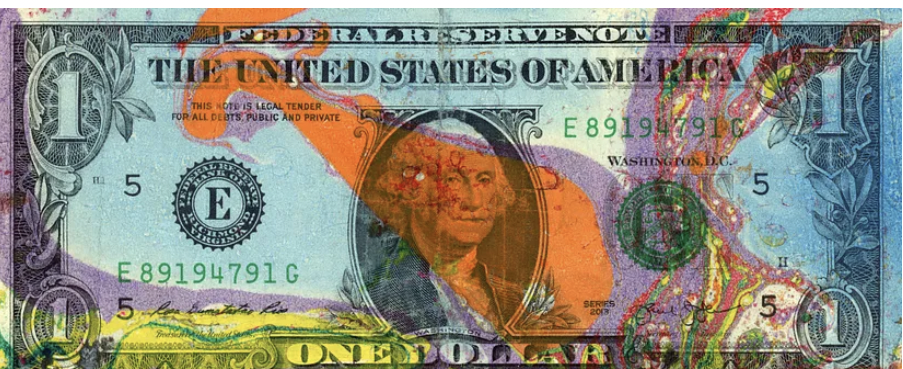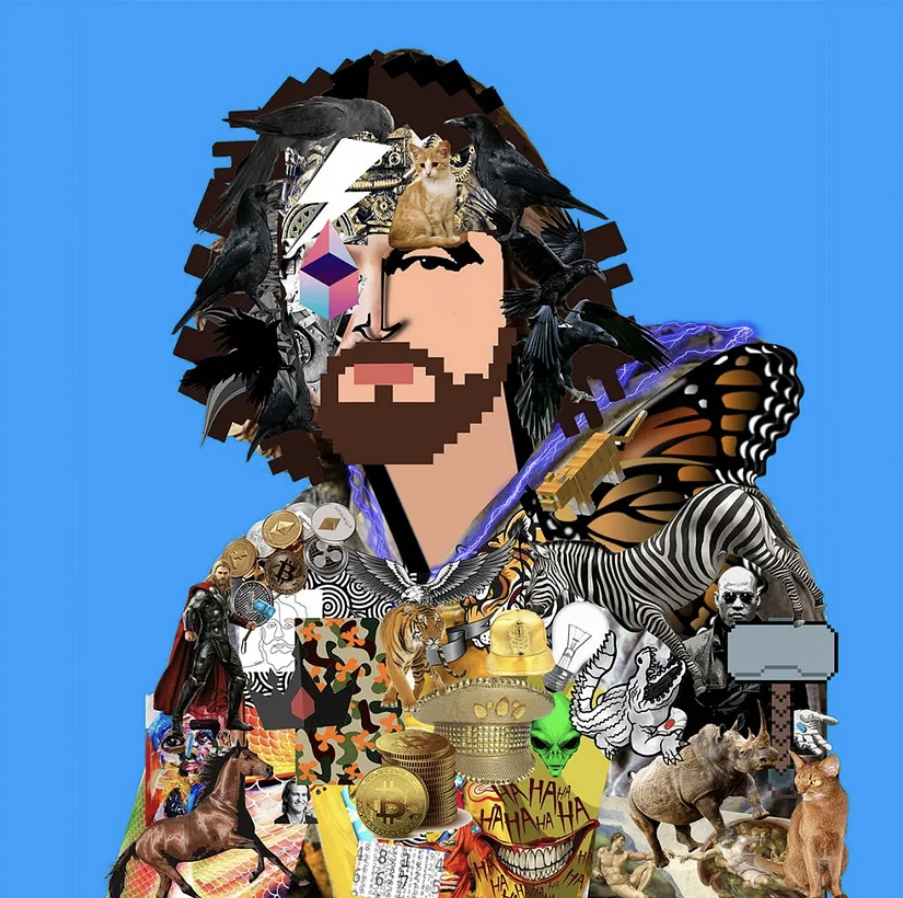“I don’t like mixing art and money”
This interview was first published on medium.com, January 26, 2023
Colborn Bell
by Anna Seaman
Colborn Bell is an intriguing sum of many parts. Perhaps best known in the crypto space for the Museum of Crypto Art (MOCA), which he founded in 2020 and to which he donated 150 of his personal collection of 1/1 NFT artworks, he is a former financier, self-declared outsider and an artist who values, above all, stories, connections and conversations.
For the sake of this interview, it is Colborn Bell the artist that I will introduce first. In February 2021, he released his NFTs, collectively known as Magic Internet Money; a series of single dollar bills painted with water marbling and then minted but, for the most part given away. They are funny, casual, and almost blasé in tone but also, searingly frank. They subvert and poke fun at the value of fiat currency, that is continuously diluted by inflation. He began making these artworks unintentionally in 2015, when an interest in suminagashi (the ancient Japanese art of water marbling) had him searching for the perfect material. Dollar bills are made of cotton and have the ideal absorbency for his chosen medium. But Magic Internet Money gained traction and now, summarise part of Colborn’s personality and ethos.
“Magic internet money is a form of rebellious expression that I continued because I like the effect that it had on people. I took something so common and ordinary and painted in a different light and it got people to think differently about money,” he says.
magic internet money #65 by Colborn Bell
The dollar bill is perhaps the most classic example of a fungible token; identical and exchanged continuously with no thought of individuality. The transition of these into non-fungible tokens, cleverly paired with the embedded metaphor of a celebration of individuality, makes the art conceptually fascinating.
“It’s a commentary on the flattening effect of capitalism that makes everyone worship that dollar and the people caught up in the Web2 system,” he says. “I’m suggesting that maybe we can extract the personality and individuality from those generic and every-day functional fungible tokens. Essentially, I’m asking how do we do more with money?”
Yet Colborn hasn’t been able to reconcile the relationship between art and money. An avid collector with thousands of 1/1 NFTs in his collection, he describes the art trade as a validation of labour but also something that removes the heart of what creativity is about.
“I don’t like mixing art and money,” he laughs. “It is hard to reconcile this because I want digital creators to get paid but I would love for there to be more conversation about stories, and connections; how these things are bringing people together, how they are helping people to rediscover and re-examine themselves rather than who is the top selling artist.”
An artist’s homage to Colborn Bell. Image courtesy Colborn Bell.
Yet Colborn doesn’t identify as an artist. He’s been making things with his hands since early childhood when, growing up in Malibu, California, he would tower blocks of Lego together, yet has always had a yearning for the esoteric. Primarily, Colborn’s status in the crypto space is as a collector, amassing many pieces of early work that, in general, have a glitchy, abrasive or loud aesthetic.
“There is a roughness to my collection which I love,” he says. “I like things that other people don’t like. I like the underdog artist; I like the outsider — I think that’s because I always felt on the outside and wanted to be invited in.”
MOCA was born from this sentiment. Enchanted by the participatory and inclusive nature of the Web3 space, Colborn founded MOCA as an invitation to join in and to question what an institution is, or stands for. “It is a fundamental inversion of the messaging that we tell artists of what a museum can be, which echoes was the fundamental shift in web3.
“Web2 was all about making the person into a personal brand or the commercialisation of person into a product, but in Web3 there is a fluidity to identity and the ability to be many different things to many different people at the same time.”
MOCA is described as a community-driven digital cryptoart museum. Established in 2020 in the Somnium Space metaverse, MOCA is now a place to build narrative and history in the NFT art space. Currently it only has one collection — The Genesis Collection, which comprises one work per artist minted prior to December 2020 in an effort to “enshrine and encapsulate the earliest creators before a mass market movement.” Artworks are donated by collectors (and sometimes artists themselves) and the point is inclusivity as well as the sparking of conversations. More recently, with the launch of ROOMS, Colborn wants to provide tools for as many people as possible to curate exhibitions and champion the value of art outside of sticky financial terms.
“I started MOCA because when I began going into virtual worlds there were only artists, marketplaces and a handful of larger collectors — half of those who were anonymous and the other half, egotistical. The idea was to create a third-party institution to begin to validate history and ethos of space and to mirror attitudes of artists. I guess you could say it was a rebellious movement against contemporary art and modern finance, late-stage capitalist ongoings that were frankly devoid of substance and meaning.”
His personal collection was mostly accrued after he opened MOCA, during the isolating times of COVID-19, when, he says, he began feeling connected to people through their art.
But collecting as a passion goes deeper than that for Colborn. “Through collection, I have tried to reassemble fragmented pieces of my identity.”
Perhaps this is a statement upon which we should all ponder. What items do we choose to hold onto in this over-stimulating world and which do we choose to let go? It’s an interesting practice for self-discovery and something I took away from my interview with Colborn.
In summary, Colborn is a rebel at heart and a supporter of the underdog — what’s not to like? Despite eschewing notions of financial value, the art he produces is gathering pace and holds high cultural value. Even if he does like to give it away, I would wager that the impact Colborn’s art and attitude has on the crypto space will outlast the disposable nature of the fungible token.



